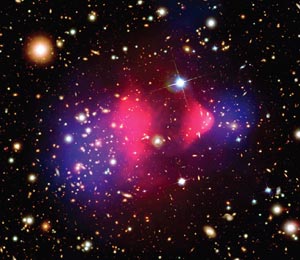The idea of dark matter in the universe dates back to the 1930s, with the observation that the gravitational force on the visible matter in clusters of galaxies could not fully account for their behaviour, implying some alteration to gravity, or the existence of non-luminous, invisible matter. Now a team in the US has used a combination of astronomical images to analyse gravitational lensing in a region where two clusters are merging. The researchers find that their observations cannot be explained by modified gravity.

While dark matter has become the focus of a range of research, from cosmology to particle physics, it has proved difficult to rule out the alternative scenario in which gravity is slightly altered from the standard 1/r2 force law. The new study, however, has discovered a system in which the inferred dark matter is not coincident with the observable matter, and the difference in position is too great to be accounted for by modifying gravity. This, the team says, provides direct empirical proof for dark matter.
The team from the universities of Arizona and Florida, the Kavli Institute for Particle Astrophysics and Cosmology, and the Harvard-Smithsonian-Center for Astrophysics has combined observations from various telescopes to build a picture of what is happening in the galaxy cluster 1E0657-558. This cluster is particularly interesting because it shows evidence that a smaller cluster has at some stage ripped through a larger cluster, creating a bow-shaped shock wave.
Using images from the Hubble Space Telescope, the European Southern Observatory’s Very Large Telescope and the Magellan telescope to provide information on gravitational lensing of more-distant galaxies, the team has created a map of the gravitational potential across the cluster 1E0657-558. This reveals two regions in which the mass is concentrated.
The team has also observed the cluster with NASA’s Chandra X-ray Observatory to measure the positions of the two clouds of hot gas that are associated with the merging galaxies. It finds that these two clouds of X-ray emitting plasma of normal baryonic matter are not coincident with the two central locations of the gravitational mass, which in fact are further apart. This suggests that the plasma clouds have slowed as they passed through each other and interacted, while dark matter in the two clusters has not interacted.
Further reading
D Clowe et. al. 2006 Ap. J. 648 L109.








